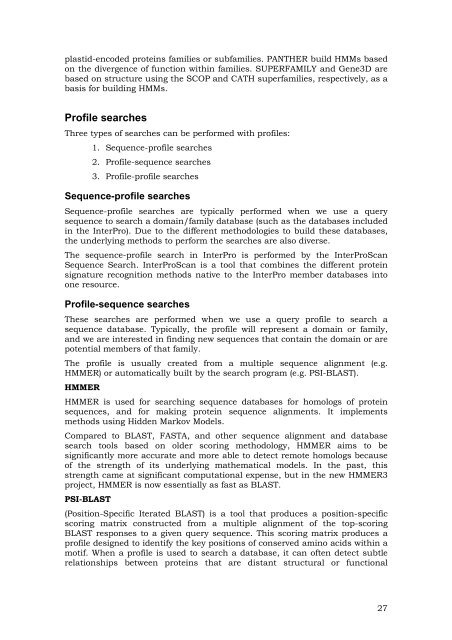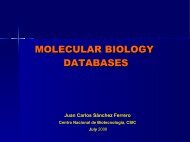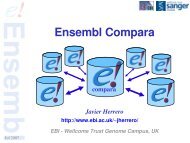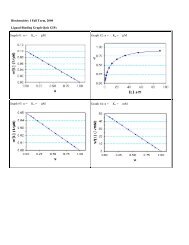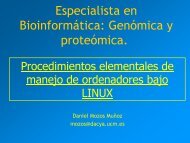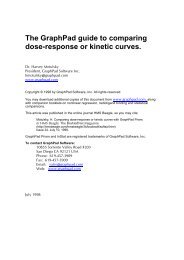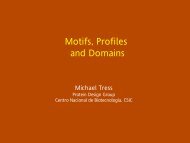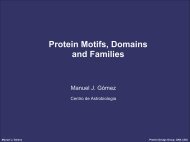Practical Course on Multiple Sequence Alignment - CNB - Protein ...
Practical Course on Multiple Sequence Alignment - CNB - Protein ...
Practical Course on Multiple Sequence Alignment - CNB - Protein ...
You also want an ePaper? Increase the reach of your titles
YUMPU automatically turns print PDFs into web optimized ePapers that Google loves.
plastid-encoded proteins families or subfamilies. PANTHER build HMMs based<br />
<strong>on</strong> the divergence of functi<strong>on</strong> within families. SUPERFAMILY and Gene3D are<br />
based <strong>on</strong> structure using the SCOP and CATH superfamilies, respectively, as a<br />
basis for building HMMs.<br />
Profile searches<br />
Three types of searches can be performed with profiles:<br />
1. <strong>Sequence</strong>-profile searches<br />
2. Profile-sequence searches<br />
3. Profile-profile searches<br />
<strong>Sequence</strong>-profile searches<br />
<strong>Sequence</strong>-profile searches are typically performed when we use a query<br />
sequence to search a domain/family database (such as the databases included<br />
in the InterPro). Due to the different methodologies to build these databases,<br />
the underlying methods to perform the searches are also diverse.<br />
The sequence-profile search in InterPro is performed by the InterProScan<br />
<strong>Sequence</strong> Search. InterProScan is a tool that combines the different protein<br />
signature recogniti<strong>on</strong> methods native to the InterPro member databases into<br />
<strong>on</strong>e resource.<br />
Profile-sequence searches<br />
These searches are performed when we use a query profile to search a<br />
sequence database. Typically, the profile will represent a domain or family,<br />
and we are interested in finding new sequences that c<strong>on</strong>tain the domain or are<br />
potential members of that family.<br />
The profile is usually created from a multiple sequence alignment (e.g.<br />
HMMER) or automatically built by the search program (e.g. PSI-BLAST).<br />
HMMER<br />
HMMER is used for searching sequence databases for homologs of protein<br />
sequences, and for making protein sequence alignments. It implements<br />
methods using Hidden Markov Models.<br />
Compared to BLAST, FASTA, and other sequence alignment and database<br />
search tools based <strong>on</strong> older scoring methodology, HMMER aims to be<br />
significantly more accurate and more able to detect remote homologs because<br />
of the strength of its underlying mathematical models. In the past, this<br />
strength came at significant computati<strong>on</strong>al expense, but in the new HMMER3<br />
project, HMMER is now essentially as fast as BLAST.<br />
PSI-BLAST<br />
(Positi<strong>on</strong>-Specific Iterated BLAST) is a tool that produces a positi<strong>on</strong>-specific<br />
scoring matrix c<strong>on</strong>structed from a multiple alignment of the top-scoring<br />
BLAST resp<strong>on</strong>ses to a given query sequence. This scoring matrix produces a<br />
profile designed to identify the key positi<strong>on</strong>s of c<strong>on</strong>served amino acids within a<br />
motif. When a profile is used to search a database, it can often detect subtle<br />
relati<strong>on</strong>ships between proteins that are distant structural or functi<strong>on</strong>al<br />
27


